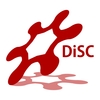
Synthesis and Prototyping
The Synthesis facility at DiSC ranges from the very traditional equipment for the realization of the designed molecules to the advanced preparative chemistry, including the manipulation of macromolecules assembly, thin film morphologies and device assembly.
New organic molecules, inorganic compounds, coordination complexes, peptides, nano-structured functional materials, supra-molecular systems, drugs, catalysts, radioactive compounds, organic-inorganic hybrid materials, micro-gels and electro-active functional polymers are daily synthesized in the DiSC laboratories. Most of them are supplied by highly pure (electronic grade) inert gases (Argon, Helium, Nitrogen) from a centralized distribution system. The gas supply is managed 24 hours a day by a dedicated team, supervising the storage and taking care of the network maintenance.
Reactive gases are managed in specialized laboratories, where particular care to safety is supported by the DiSC safety technical service. Liquid nitrogen and helium storage reservoirs are housed at DiSC and they are easily accessible to all the labs.
Some special synthesis facilities at DiSC can be cited:
An ISO7 Clean Room (CR)
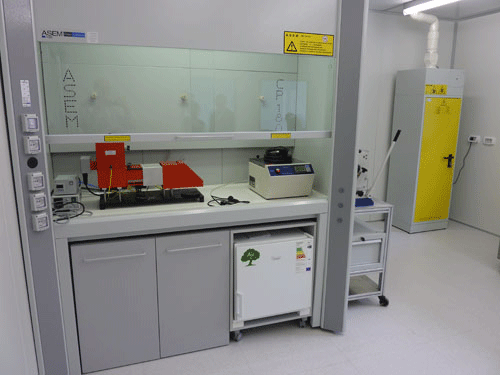
The Clean Room (CR) housed at DiSC is a laboratory of ca. 30 m2 with a controlled low concentration of particles in its air. 10˙000 m3/h of air are pumped in the CR through High Efficiency Particulate Air (HEPA) filters, the inner atmosphere is constantly recirculated on those filters and the flows are kept laminar. The amount of suspended particles having diameter higher than 0.5 microns is maintained lower than 400˙000 per cubic meter, thus satisfying the ISO7 classification on the ISO reference scale or Class 10˙000 on the FED STD 209E standard. The pressure inside the CR is higher than the outside, the temperature is maintained at (22 ± 2)°C, the relative humidity is fixed at (50 ± 10)%. The laboratory is equipped with a ca. 2 m wide chemical hood, a ventilated cabinet for the safe storage of chemicals, a fridge, a plasma oven operating on pure gases, inert or reactive, or mixtures, at 13.56 MHz with a maximal total power of 50W, an hydraulic pump for manually sintering of materials, a full set of chemical glassware, a computer as laboratory notebook. The main instruments actually housed in the CR are: 1) a spin coater capable of reaching 5˙000 rpm speed in a programmable sequence of controlled acceleration/deceleration steps; 2) a collimated UV light system suitable for photolithographic processes with a 300 W mercury lamp and an optical bench aligning the light rays in parallel paths on a plate bearing the targets; 3) an UV-O3 unit which can generate ozone by UV radiation, for reaction activation steps or for surface cleaning; 4) a metallic hot plate with Pt100 thermocouple; 5) a standard balance with 0.1 mg sensibility.
The CR is particularly well equipped for the microfluidics research and development, ranging from fast prototyping techniques for the rapid fabrication of custom polymer devices by soft photolithography to the surface modification of microchannels by wet chemistry methods. The CR can be considered a complete microfluidics toolbox for the study of reaction or surface absorption kinetics. The CR is actually dedicated to the chemical functionalization of carbon nanostructures for solar energy conversion, to the use of nanocellulose as a platform for bio-inspired functional materials and to the preparation of functional supramolecular organogels.
The CR is managed as a tool suitable for fundamental and applied research on microfluidics in the Chemistry, Physics, Biology and Medicine perspectives, thus it houses different realities, from the training of young researchers to the development of projects for the technology transfer to local industry.
location at DiSC: 215-02-083
contacts: michele.maggini@unipd.it
Automatic synthesizers
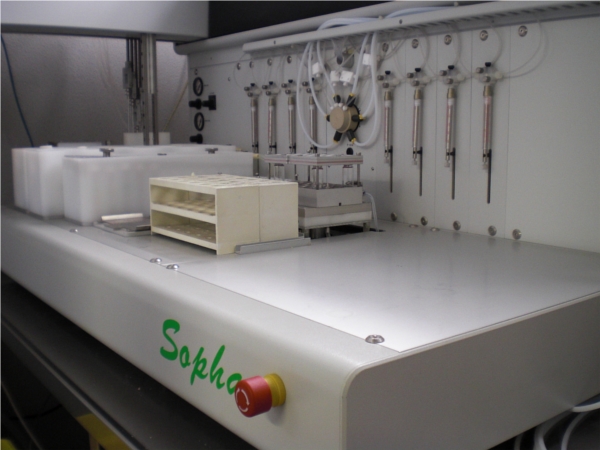
Zinsser Sophas automatic system for peptide and small molecule synthesis
The synthesizer allows for the completely computerized synthesis of peptides and small molecules. In particular, it permits the dilution and addition of amino acids and coupling reagents, efficient washing steps in between each coupling, the protection and de-protection of side chains, and cleavage of the final product from resin.
location at DiSC: 170-00-060
contacts: leonard.prins@unipd.it
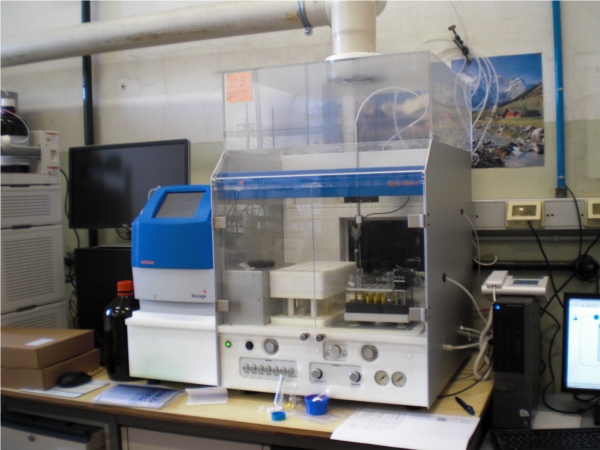
Biotage® Syro Wave™ Automated Microwave and Parallel Peptide Synthesizer
The Biotage® Syro Wave™, currently housed at DiSC in the frame of a collaboration with Fresenius-Kabi Antiinfectives (Villadose, Rovigo), is a robotized computer controlled peptide synthesizer. The equipment allows for performing syntheses of peptides by the conventional solid phase protocol on the parallel reactor block. The reactor vial can be transferred to a microwave cavity to drive difficult couplings to completion. The system is fully computer controlled, thanks to the Syro XP software, which allows for the calculation of the stoichiometric amounts and volumes of amino acids and reagents, as well as detailed programming of the reaction conditions. The equipment is capable of managing synthesis composed of a number of completely different steps, each specifically tailored. Single or multiple couplings can be driven, and a complete freedom in the choice of coupling strategies is possible within any synthesis cycle.
location at DiSC: 215-02-100
contacts: fernando.formaggio@unipd.it
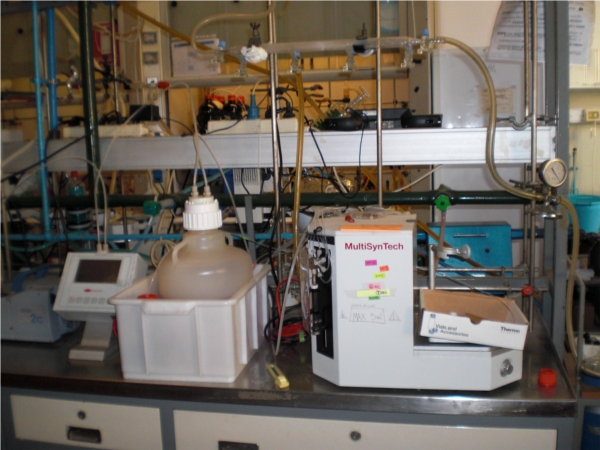
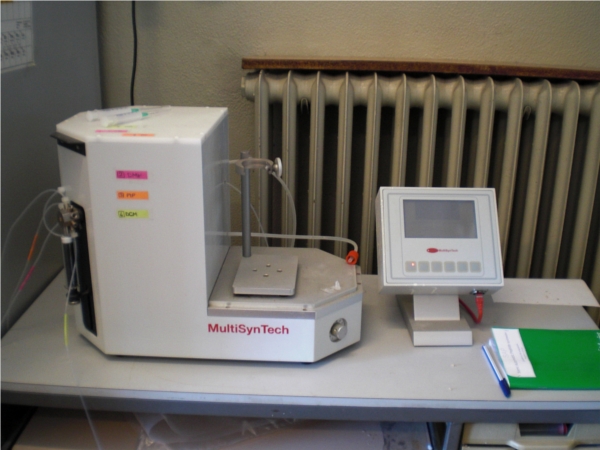
Two Biotage® SAP Syro Multi Syn Tech
Two Biotage® SAP Syro Multi Syn Tech systems are housed at DiSC. They are semi-automated peptide synthesizers. An external controller allows to manage some steps of the synthesis protocol and drive it authomatically. The reaction scale ranges from 0.5 to 20 mmol, while an eight valve pump allows for controlled transferring of up to seven different solvents and reagents. The high level of accuracy in the amount of added reagents is guaranteed by the digital syringe pump.
location at DiSC: 215-03-084; 215-02-100
contacts:
marta.dezotti@unipd.it
alessandro.moretto.1@unipd.it
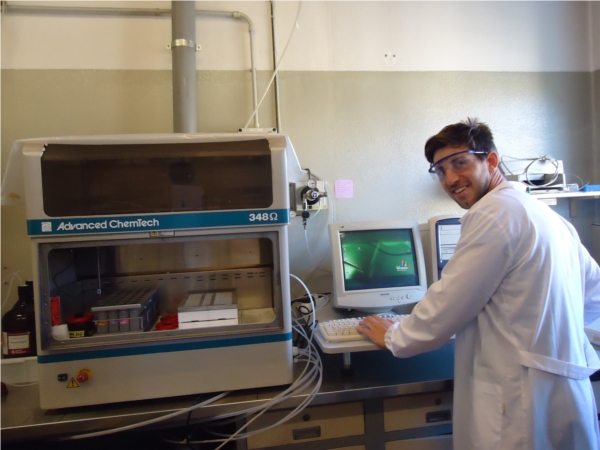
Advanced ChemTech 348 Ω Multiple Peptide Synthesizer
The Advanced ChemTech 348 Ω Multiple Peptide Synthesizer is a fully automatic machine for the parallel synthesis up to 96 peptides and oligomers at 10-100 µmol scales. The instrument is based on a pipetting robot with a single needle. Five solvent positions and 36 additional reagent bottles guarantee the flexibility to run complex protocols. The nitrogen-assisted bottom filtration quickly and thoroughly empties the reactor while maintaining an inert atmosphere, resulting in quick emptying. Due to its flexibility, it can be utilized in a broad variety of resin-supported chemistry.
location at DiSC: 215-03-081
contacts: marina.gobbo@unipd.it
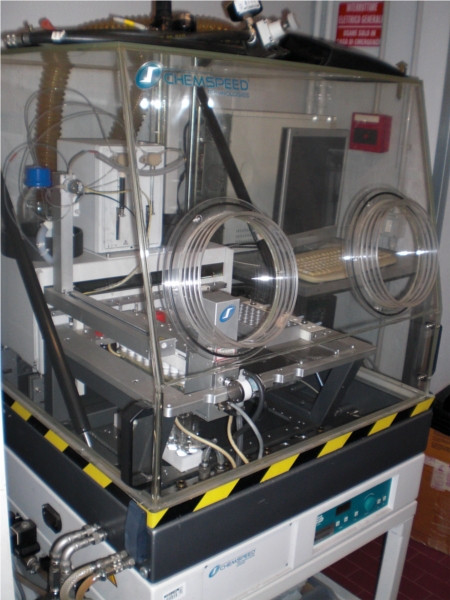
A CHEMSPEED Technologies ASW 2000 for computerized multiple reaction setup.
location at DiSC: 170-00-017
contacts: giulia.licini@unipd.it
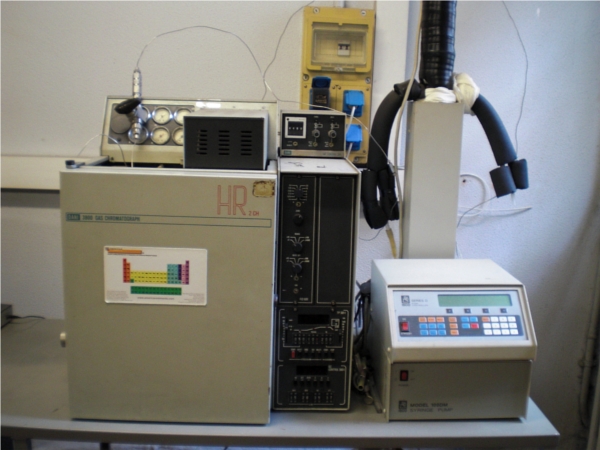 A home adapted synthesizer system for reactions in supercritical carbon dioxide developed from a DANY 3800 GC HR2C
A home adapted synthesizer system for reactions in supercritical carbon dioxide developed from a DANY 3800 GC HR2C
Temperature, flux and pressure control facilities of a DANY 3800 GC system have been adapted to build an home made synthesizer capable of hosting a supercritical carbon dioxide environment as reaction vessel. The mechanical and electronic improvements applied to the apparatus have been designed and realized at DiSC.
location at DiSC: 170-00-018
contacts: sandro.campestrini@unipd.it
Laser Ablation Synthesis of Nanoparticles (LASiS)

Plasmonic, magnetic and other nanoparticles are produced by Laser Ablation of bulk materials under solvents. Nano-second pulses of Quantel Nd:Yag laser are used at 1064, 532 and 355 nm.
location at DiSC: 215-01-141
contacts: moreno.meneghetti@unipd.it
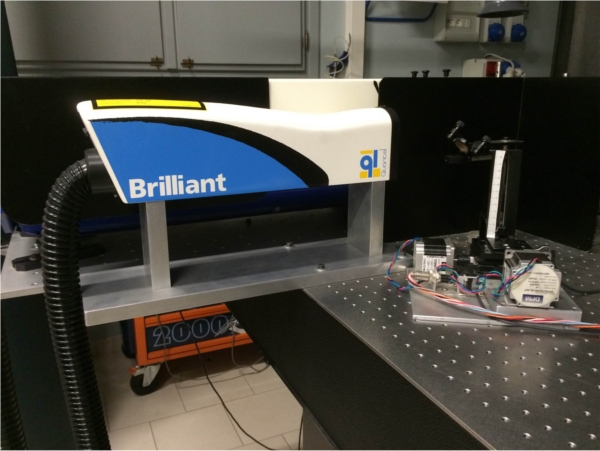
Plasmonic, magnetic and other nanoparticles are produced by Laser Ablation in Liquids (LAL or LASiS) of bulk materials under solvents. High repetition rate nanosecond pulses of a Quantel Nd:Yag laser are used at 1064 nm with a dedicated automatic set-up.
location at DiSC: 215-01-141
contacts: vincenzo.amendola@unipd.it ; moreno.meneghetti@unipd.it
Electrospinning
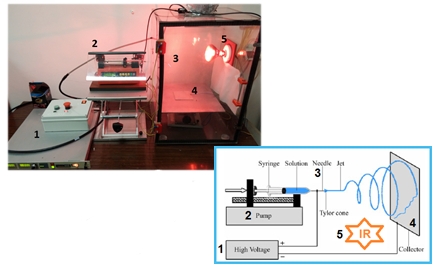
A home-made electrospinning fiber production system is housed at DiSC. Composite polymers can be obtained as fibers with diameters in the order of some ten nanometers, while intercalation phenomena and intermolecular interactions can be modulated and studied. The DiSC electrospinning system enables a working voltage up to 20 kV. The flow rate of the precursor can be set in the range from 0.1 to 0.005 mL/min by an electronically controlled low-volume syringe that allows to work with small amount of samples. Temperature can be raised up to 50°C.
location at DiSC: 215-01-073
contacts: carla.marega@unipd.it
Vacuum and (ultra) high vacuum synthesis
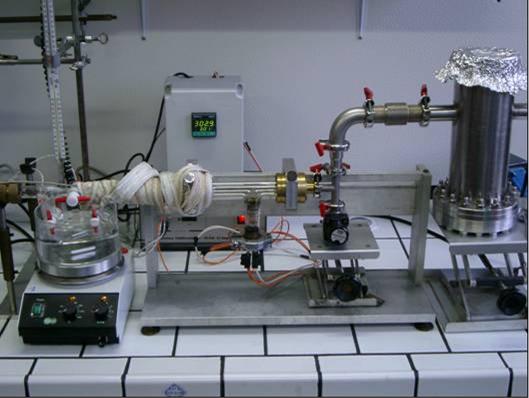
Cold-wall thermal CVD reactor
Home-made apparatus operating at low pressure for the synthesis of small-size (1×1 cm2) samples at deposition temperatures up to 600°C.
contacts: alberto.gasparotto@unipd.it
location at DiSC: 210-03-009
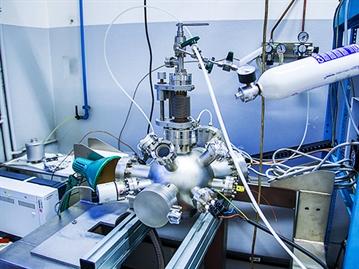
Home-made cold-wall CVD reactor
This reactor is characterized by a resistive Joule heating system with maximum temperature 1250 °C, heating and cooling rates up to 33°C/sec and operating pressure from ambient to 10-8 mbar.
contacts: gaetano.granozzi@unipd.it ; stefano.agnoli@unipd.it
location at DiSC: 215-01-057
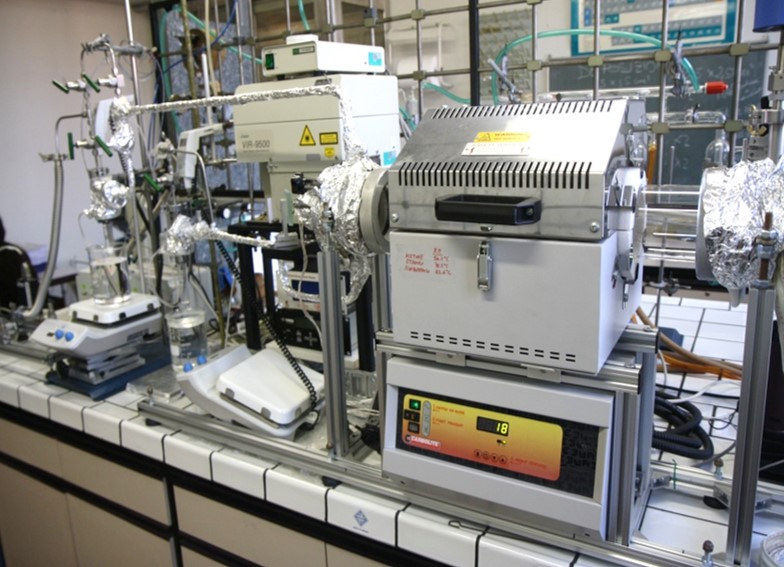
Hot-wall thermal CVD reactor
Home-made low pressure apparatus for the synthesis of relatively large (5×5 cm2) samples. The reactor is equipped with a FT-IR spectrometer for the in-situ study of gas-phase reactions and can operate at temperatures as high as 1000-1200°C.
contacts: alberto.gasparotto@unipd.it
location at DiSC: 210-03-009
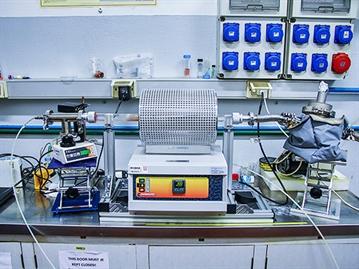
Tubular hot-wall CVD Carbolite 12/38/250 with aerosol generator
This system is equipped with quartz, alumina and pyrex tubes. It is connected to four mass-flow controllers that allow to control the atmosphere inside the reactor, operating at pressures from ambient to 10-3 mbar, and supports up to 9 programmable temperatures with the maximum at 1200 °C. This system allows classical chemical vapour deposition (CVD) synthesis, as well as different thermal treatments under controlled atmosphere. In addition, it has an integrated particles generator for aerosol synthesis.
contacts: gaetano.granozzi@unipd.it ; stefano.agnoli@unipd.it
location at DiSC:215-01-057
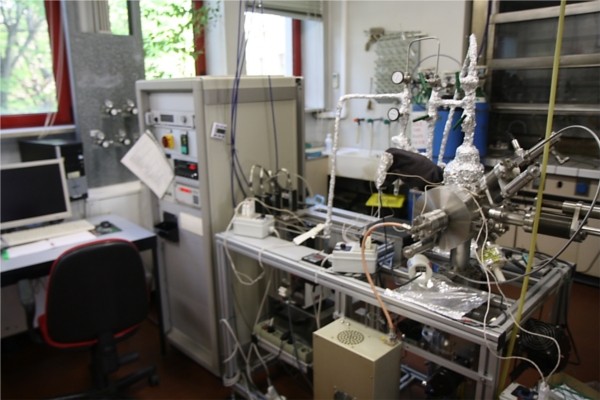
Plasma-assisted Plasma Enhanced- Chemical Vapor Deposition (PE-CVD)/sputtering reactor
Home-made apparatus provided with a radio-frequency plasma generator. It can be operated for both PE-CVD and RF-sputtering experiments. Thanks to the mild plasma conditions, material deposition even on thermally-labile (polymers, paper,…) substrates is possible. Equipped with a laser reflection interferometer for the real-time monitoring of the growth process.
contacts: davide.barreca@unipd.it
location at DiSC: 210-02-011
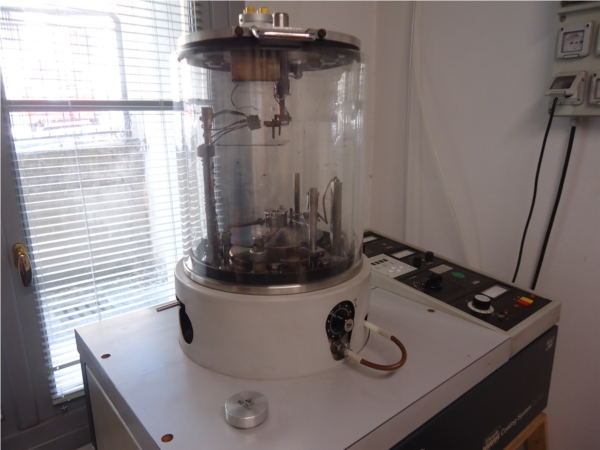
Edwards resistive thermal evaporator
Edwards resistive thermal evaporator gives access to thin-film deposition of metals (Au, Al, Ag, Ca) and organic small molecules on solid substrates. The high vacuum system, based on a rotative and a diffusive pump, allows reaching working pressures down to 10-5 mbar. Control on sample temperature is achieved by a resistive element. Furthermore, the sample-holder can be coupled with different masks to control deposition geometry, specifically designed to build plastic electronics devices (OLED, OFET, BHJ). Film thickness is monitored with nanometric accuracy by a quartz microbalance. The vacuum chamber can be converted to plasma oxygen system to treatment.
The evaporator facility is mostly used to realize contact of optoelectronic devices, such as solar cells and electrically pumped energy-transfer devices. Noble metal thin-films, when deposited on self-assembled nanospheres, are used as SERS substrates called film-over-nanosphere (FON).
contacts: renato.bozio@unipd.it ; camilla.ferrante@unipd.it
location at DiSC: 215-00-098
Synthesis from solutions, suspensions and melts
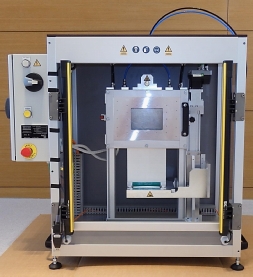
Sol-gel dip-coater
The dip-coater is a controlled speed immersion/extraction coater of silica samples to fix the homogeneity and thickness of sol-gel layers. This facility works also in controlled atmosphere and is used for the investigation of the silica layers deposited to protect Cultural Heritage Artefacts.
contacts: renzo.bertoncello@unipd.it
location at DiSC: 215-03-048
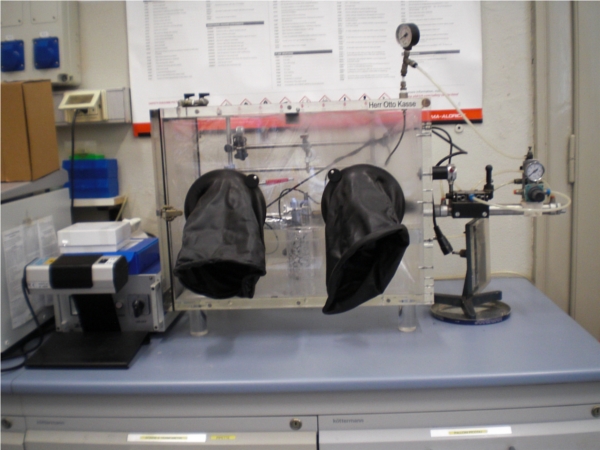
Custom made dip and spray coaters
For the deposition of inorganic and hybrid films and coatings under controlled atmosphere.
contacts: silvia.gross@unipd.it
location at DiSC: 215-01-067
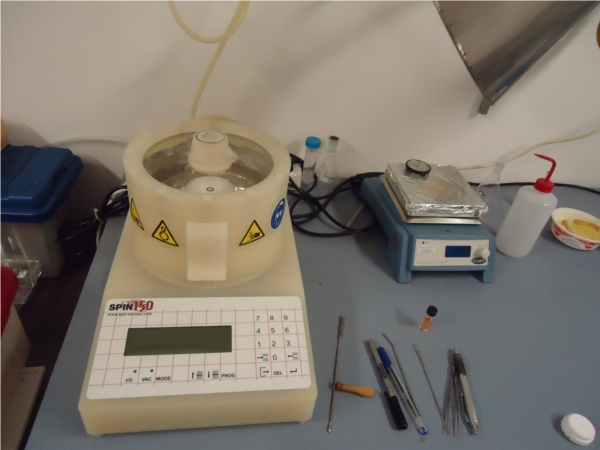
Programmable spin-coater and dip-coaters
The programmable spin-coater allows depositing thin-films, starting from solutions, on different substrates under controlled atmosphere (nitrogen overpressure), angular speed, angular acceleration and dwell time parameters. Two dip-coaters allow the simultaneous deposition on a number of substrates, in different geometries (perpendicular and tilted geometry). A software controls immersion and emersion speed parameters.
Coating facilities are mostly used in the synthesis of quantum dots superlattices, either through electrostatic self-assembly (ESAM) and evaporation-induced self assembly (EISA) techniques.
contacts: renato.bozio@unipd.it ; camilla.ferrante@unipd.it
location at DiSC: 215-00-098
Sample handling and conservation
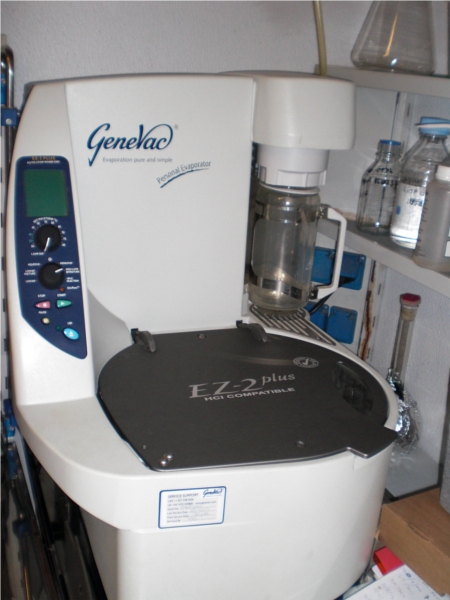
GeneVac EZ-2 Evaporation centrifuge
The GeneVac EZ-2 equipment performs high efficiency solvent removal, both for the concentration of samples and for complete drying, even in case of high boiling temperature solvents. There is no need of sample transfer: eppendorf and vials can be managed directly; a manifold of samples, if chemically compatible, can be treated simultaneously.
contacts: leonard.prins@unipd.it
location at DiSC: 170-00-060
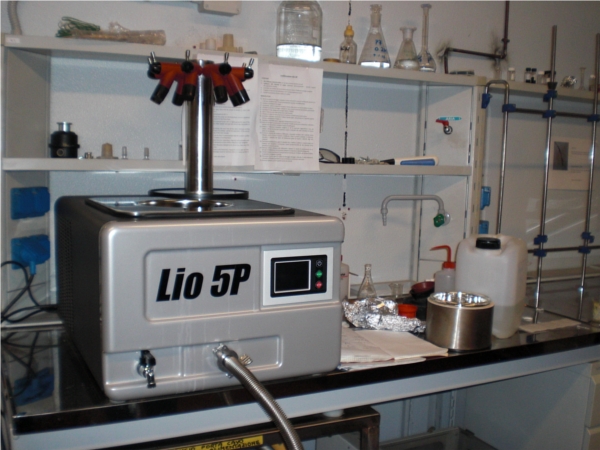
LIO5P freeze-dryer
Lyophilisation is performed by the DiSC LIO-5P at minimum condensing temperature of -55°C, while the measurable temperature ranges from -120°C to +100°C, with a condenser volume capacity of 7.2 L. The freeze dryer system is equipped with a high flow pump for fast procedures, while the level of vacuum ranges from 0.001 to 100 mbar. A manifold of eight product shelves allows for freeze drying of arrays of samples. It is equipped with a corrosion-resistant stainless steel condenser, which is thermally insulated and acts as a trap for solvents.
contacts: cristina.paradisi@unipd.it
location at DiSC: 170-00-017
Inert atmosphere glove boxes
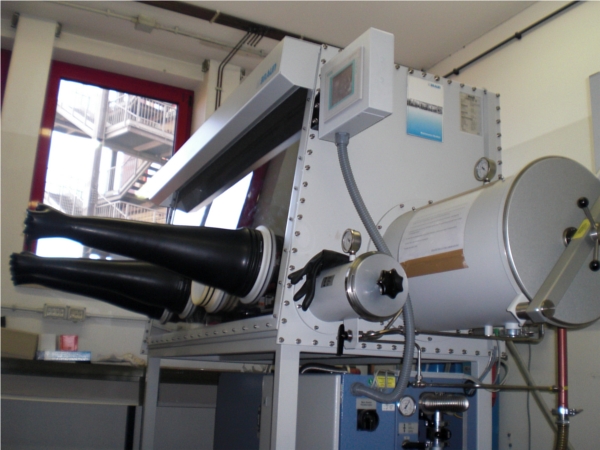
Different types of glove boxes are housed at DiSC for controlled atmosphere syntheses, tests, prototype assembly. They are usually developed to protect reagents and operations from the outer atmosphere, in some cases they protect ambient from a inner dangerous condition. The most diffused is the dry box, housing nitrogen or argon atmosphere with controlled concentration of oxygen and humidity, typically lower than 1ppm. The gas in the working area is kept pure by constant recirculation on filters and catalysts, the refilling is usually fed by the department distribution network. Special cases can be cited, as glove boxes for the manipulation of radioactive substances or boxes built around instruments to perform experiments in a controlled atmosphere.
contacts: cristina.tubaro@unipd.it ; cristiano.zonta@unipd.it ; pierluigi.zanonato@unipd.it
location at DiSC: 210-04-014 ; 170-00-017 ; 215-00-043
Mechanochemistry and sonochemistry
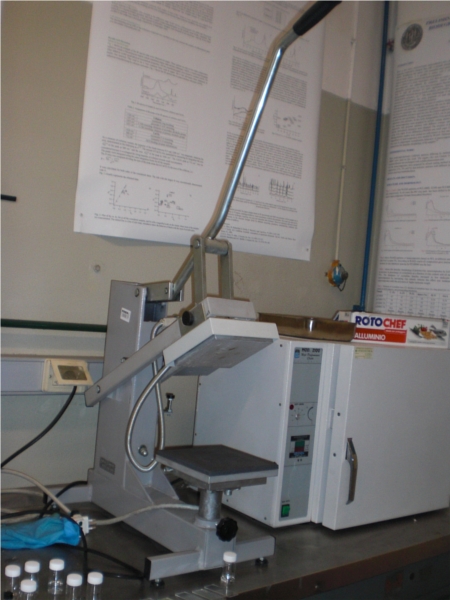 Hot Press Film assembler
Hot Press Film assembler
The Hot Press housed at DiSC allows to prepare thin polymer-based films up to a 20cm x 20cm area from pellets or powders. The press is equipped with heating unit providing temperature control up to 300°C, timer and flat plates attachments made of different materials, for an experimental conditions monitoring that allows to obtain films with high thickness homogeneity at ca. 0.5mm.
contacts: carla.marega@unipd.it
location at DiSC: 215-01-073
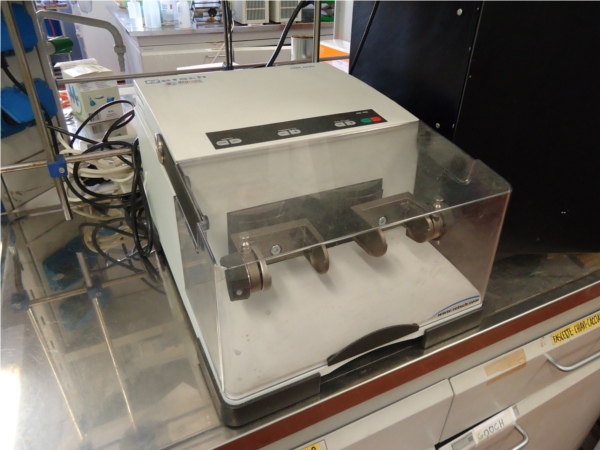 Mixer mill Retsch MM400
Mixer mill Retsch MM400
Efficient and reproducible grinding, mixing and homogenization of samples can be performed by impact and friction, up to 30 Hz, with the mixer mill MM400. Powders or suspensions, both in dry or wet conditions, can be treated.
contacts: michele.maggini@unipd.it
location at DiSC: 170-02-008
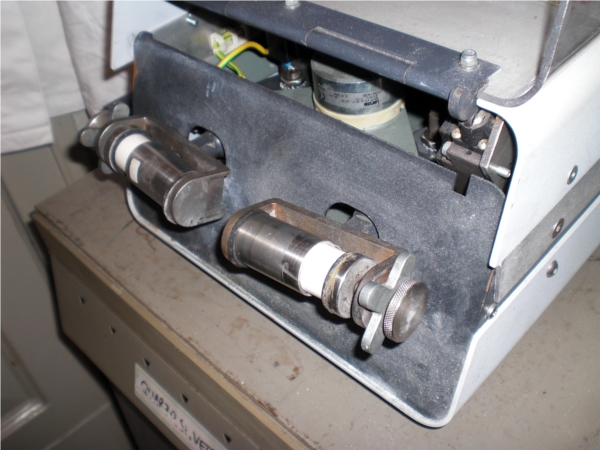 Ball miller Retsch MM200
Ball miller Retsch MM200
For the milling/grinding of samples and for mechanosynthesis, up to 60 Hz.
contacts: silvia.gross@unipd.it
location at DiSC: 215-01-067
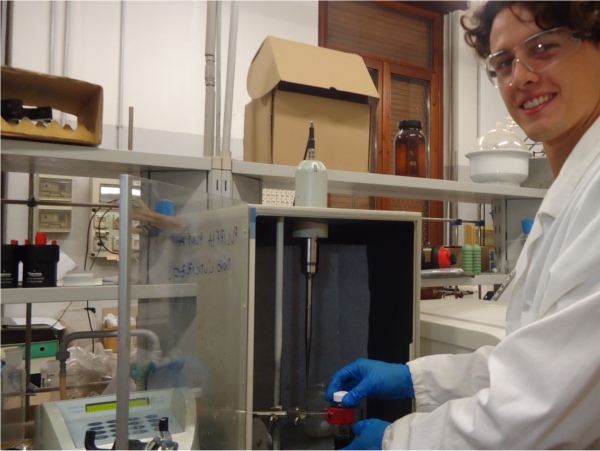 Minisonix Sonicator® 3000 Ultrasonic Cell Disruptor
Minisonix Sonicator® 3000 Ultrasonic Cell Disruptor
The Minisonix Sonicator housed at DiSC is equipped with a 3 mm titanium tip probe and sound enclosure. The applied waves are set at 20 kHz with adjustable “pulse on” and “pulse off” programmable times to deliver a maximum power of 600 watts. The sonicator is suitable for a wide range of applications, from the size reduction of solid particles in suspensions to the mixing of compounds, from the DNA shearing to the disruption of cells.
Actually it is mainly dedicated to the processing of carbon nanustructures to promote dispersion in solution, chemical reactions and formation of nanocomposite materials.
contacts: enzo.menna@unipd.it
location at DiSC: 170-01-009
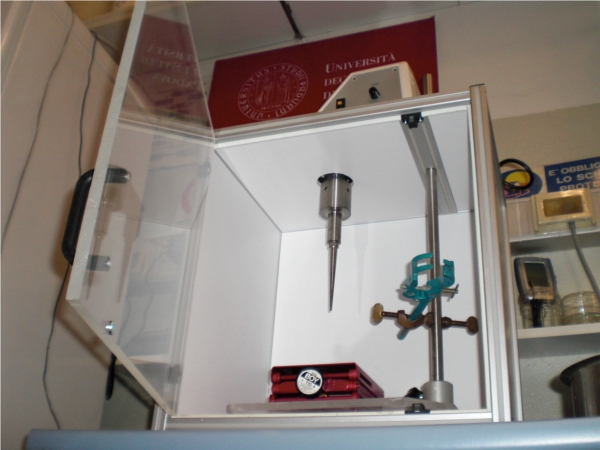 Sonicator Laborsonic P Sartorius Stedim ultrasonicator
Sonicator Laborsonic P Sartorius Stedim ultrasonicator
For the homogeneization of miniemulsions. Maximum acustic power 400 W/cm2, equipped with a 3 mm titanium tip.
contacts: silvia.gross@unipd.it
location at DiSC: 215-01-067


